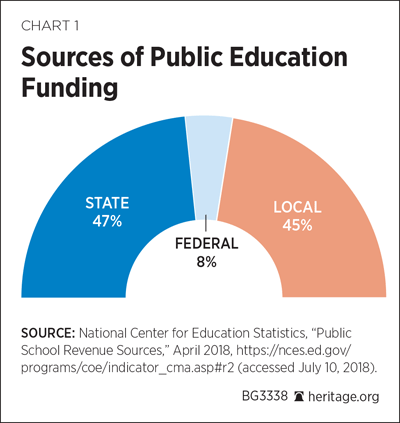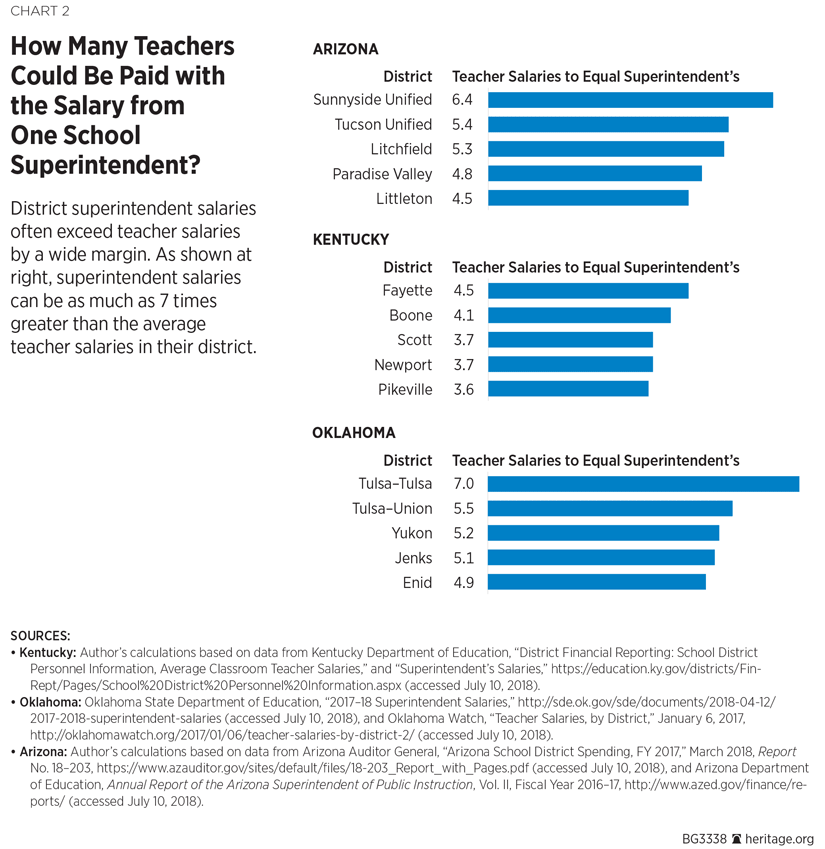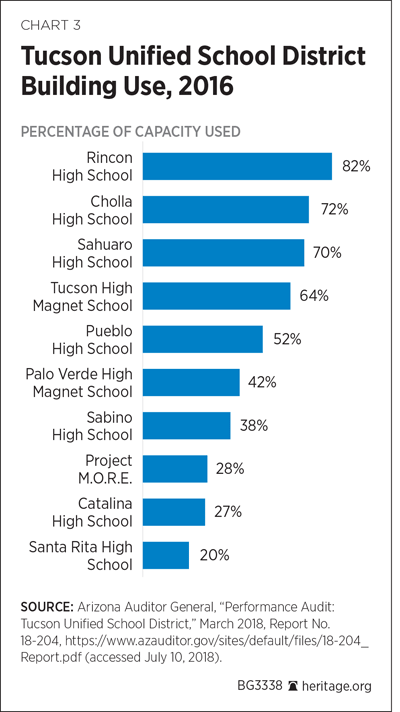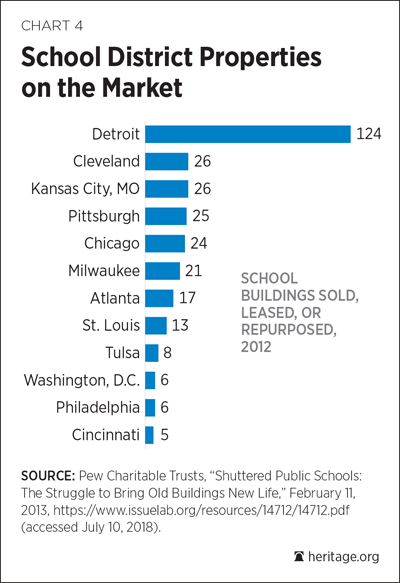For many families and students in West Virginia, Kentucky, Oklahoma, Arizona, Colorado, and North Carolina, spring 2018 will be remembered for public school closures and employee protests that interrupted the school year. The protests were part of a political firestorm involving an otherwise mundane policy topic: district school finance.
“When are the students going to be put first?” Salina Villanueva asked her child’s Arizona school district in an e-mail during the administrator and teacher strikes earlier this year.REF “It’s a shame high school seniors are being threatened to not have their official transcript released if they do not make up those days…with no regard to summer jobs, summer college, [those who are going to] military boot camp, [or will be] deployed, etc.”
Villanueva’s experience demonstrates how district administrators and teachers politicized school spending. A school tutor asked Villanueva’s daughter to help create propaganda in favor of the striking administrators and teachers.
“Whether I support [the group leading the strike] is neither here or there,” Villanueva said. “It is my right as a parent to know if my daughter will be told to participate in something that clearly has nothing to do with her without my consent/approval, especially since she’s only a 4th grader.”
The strikes and school closures that started in West Virginia spread from state to state as lawmakers capitulated to school district administrator and teacher demands. In nearly every case, state lawmakers met the strikers’ demands to increase state spending on district schools in order to end the walkouts. Oklahoma and Kentucky lawmakers even raised taxes as part of agreements to end the strikes.REF In Arizona, school district special interest groups are supporting an education finance proposal that would raise taxes on the wealthiest state taxpayers.REF
District employees in at least four states have signaled their support for strikes to demand more spending on district schools:REF
- The president of the teacher union in Indiana said the special interest group will be watching this year’s state budget negotiations to determine whether to close schools in protest.REF
- Louisiana’s teacher union polled its members about closing schools and going on strike.REF
- Nevada’s Clark County school board (which oversees Las Vegas schools, among others) called for more state funding for schools and mentioned the strikes in Arizona and Oklahoma as inspiration.REF
- In Washington State, after legislators increased school funding by 25 percent in 2018 alone—71 percent over the past decade—administrators and school employees are threatening to strike again demanding more money.REF
Meanwhile, support for strikes and more district school spending from state budgets is still a regular part of national teacher union campaigns. Earlier this year at the American Federation of Teachers’ (AFT) annual conference, union President Randi Weingarten praised administrators and teachers that went on strike:
Like so much of the recent activism, the teacher walkouts are stoking a movement for social justice, for workers’ rights, for women’s rights, for civil rights and children’s rights, for decent healthcare and well-funded public schools, for safety—on the streets and in our schools.REF
At the National Education Association’s annual meeting, delegates voted to create a teacher strike fund to support future administrator and teacher strikes.REF
But are increased taxes and state budgets the best place for teachers to turn for more spending? At some point, higher taxes cause high-income businesses and individuals to relocate, as demonstrated in Maryland and Connecticut, to name just a few, over the past decade.REF
As for state budgets, rising health care costs are demanding more from state general funds, leaving less for other state priorities like education.REF While Obamacare increased federal taxpayers’ share of health care spending in recent years, Medicaid spending is increasing and now accounts for approximately 20 percent to 25 percent of state spending.REF
Public pensions are also in a crisis. The Pew Charitable Trust reports that states have a total of $2.6 trillion in pension assets and $4 trillion in liabilities.REF Without solutions to solve this imbalance, “the impact on other essential [state] services—and the potential for unpaid pension promises—will increase.”
Since 2011, 10,000 Americans have turned 65 every day, making retirement benefits and public health care costs for the elderly a huge fiscal problem for federal and state officials.REF State lawmakers will not be able to make larger withdrawals from the state general fund every year in perpetuity to increase K–12 spending.
Before rushing to raise taxes and increasing taxpayers’ burdens, lawmakers and voters should urge districts to use resources more efficiently for the benefit of students. Likewise, as district administrators and teachers prepare to strike in other states, state policymakers and families should ask what districts are doing in their state with the resources they already have before demanding that state lawmakers find more money in the state budget.
Ultimately, school district offices control school budgets and teacher salaries. District waste, administrative spending, fraud, and poor spending habits keep millions of taxpayer dollars from being used for priorities like salaries and instruction.
How Do Taxpayers Pay for District Schools in the U.S.?
Before analyzing the spending of school districts involved in the past year’s protests, it is helpful to review how taxpayers fund education in the U.S. Traditional district school funding formulas are complicated, opaque systems rarely clear to the average taxpayer, and once taxpayers are informed how much taxpayers spend on average per student, support for increasing funding decreases by 15 percentage points.REF
A nationally representative survey conducted annually by the journal Education Next asked respondents a general question about school spending: How much do we spend per student in district schools? In 2017, the survey found respondents underestimated how much is spent per student on district schools by $4,000.REF
Although every state’s school finance formula is different, they have two common characteristics. The first is simple: K–12 district schools are governed by district offices that determine school budgets, often negotiating pay scales with teacher unions. The second common characteristic: Most district schools around the country receive taxpayer money from the same three sources: the federal government, local property taxes, and the state general fund. (See Chart 1.)

Data show that, on average, state budgets (which, as discussed above, are increasingly strained) provide less than half of all education spending.
As for turning to the federal government, cushioning local schools is not Washington’s responsibility. The two largest federal K–12 education budget items—Title I of the Elementary and Secondary Education Act and the Individuals with Disabilities Education Act—reflect Washington’s priorities of helping students from low-income families and children with special needs, respectively.REF Besides, with baby boomers retiring by the thousands every day, putting federal commitments to Social Security, Medicare, and Medicaid on an unsustainable course, administrators and teachers will have little help from Washington.
Instead of increasing taxes or state or federal funding, disgruntled school employees should take another look at school district budgets.
In some cases, millions of taxpayer resources meant for students and teacher salaries are misdirected due to poor budgeting and spending practices on the part of the school districts themselves. State lawmakers should require that districts clean up the waste, fraud, and abuse.
Bloated School District Administration
Data from around the country demonstrate that districts and schools have hired far more administrative, non-teaching employees over the past 30 years than teachers.REF The number of non-instructional administrators and staff has increased by nearly 50 percent since 1992, while the number of students has only increased by 17 percent and the number of teachers by 32 percent.
Some of these administrators make significantly more than teachers. In Jefferson County, Kentucky (JCPS), the state’s largest district, a 2014 audit found 150 central office positions with salaries of $100,000 or more per year.REF For comparison, Charlotte, North Carolina, a district similar in size to JCPS, has just 53 administrators with salaries greater than $100,000.REF The average teacher salary in JCPS is $63,000.REF
In addition to Charlotte, Kentucky’s auditors compared JCPS to four other districts with similar enrollment, student demographics, and revenue and spending levels.REF If JCPS reduced its administrative spending ($119 million annually) to the average of these 5 districts ($108 million), JCPS would be able to use the $11 million difference to increase all of the salaries for the district’s 6,000 teachers by $1,800 or provide targeted bonuses to higher performing teachers.REF
Of all school district administrators, superintendents make eye-popping salaries in some cases. In Kentucky, the superintendent of Fayette County schools makes more than $266,000, four-and-a-half times the salary of the average district teacher. (See Chart 2.) In Scott, Newport, and four other counties, the superintendents make almost four times the average teacher in those districts.

JCPS’s problems—from high administrative spending levels to low student performance—have persisted for so long that state officials are considering a state takeover of the district.REF But Kentucky is not the only state with data such as these. In Oklahoma, the Tulsa superintendent makes nearly $320,000 in salaries and benefits, seven times the average annual salary and benefit package for Tulsa teachers. (See Chart 2.)
In Arizona, the Sunnyside Unified District superintendent makes more than six times the average district teacher. (See Chart 2.) In Tucson, the superintendent makes more than five times the average teacher.
Tucson Unified School District’s (TUSD) superintendent makes more than $272,000 per year, while the average teacher makes $50,000 in the district.REF Yet Tucson has seen enrollment drop by some 14,000 students between 2000–2001 and 2015–2016.REF While a superintendent’s decisions are not solely responsible for declining enrollment, lawmakers and taxpayers should ask how the district is adjusting its spending, what it is doing to improve student outcomes for those who remain, and how it plans to reform teacher compensation to reward successful educators.
News reports suggest that the response of the TUSD superintendent to recent funding increases is surprising. After state lawmakers enacted a budget meant to provide all teachers in the state with raises of 20 percent by 2020, TUSD announced it would not improve teacher pay by this amount.REF He said “he expects to spread that money around to all ‘educators’ who touch the lives of children—even the janitors,” a surprise since “the governor promised [such raises for teachers] and the state Legislature allocated enough for the district to cover.”REF
Vacant and Underused School Facilities
Vacant and underused school facilities are a problem for many school districts across the country. They are a pervasive problem in TUSD, where district high schools operate at just half-capacity, on average, according to state audits.REF

As a result, the district’s plant operating costs per student are one-third higher than comparable districts in the state.REF When resources are dedicated to maintain empty classrooms, less money is available for teachers and students.
TUSD officials are making it difficult for private and charter schools to purchase vacant district buildings, limiting student learning options. In a move that rebuked state lawmakers, TUSD is rushing to sell a vacant school building this summer so that the district will not be forced to consider offers from public charter schools and private schools.REF Later this year, a new Arizona law goes into effect that says school districts cannot accept an offer on a vacant school building lower than an offer made by a public charter or private school.REF
A school board official was quoted in local media saying, “And I’ll just come out and tell you, if we are going to sell a property, I would rather have that land used to bring more students into our district rather than sell that property to a charter that will take students out of our district.”REF
Tucson is not unique.
Arizona state auditor reports have also found that Scottsdale Unified School District (SUSD) uses 66 percent of its building capacity.REF The district could have saved $3.8 million if it had maintained space commensurate with the average square footage of “peer districts” (districts similar in size and location). If buildings had been sold, leased, or otherwise repurposed and these funds applied to teacher salaries, the district could have given a $3,000 bonus to each of the district’s 1,300 teachers—or provided higher bonuses to exceptional teachers.REF
In Oklahoma City, Oklahoma’s largest district, the district spends $2.4 million annually to maintain 1,000 empty classrooms.REF The district reports that nearly 40 percent of elementary school seats are empty and nearly one out of four seats in middle and high schools is empty—resulting in one-third of all “instructional space” going unused.REF In fact, the Page Wilson High School building sat empty for more than 20 years, “a magnet for the homeless, as well as ghost hunters,” according to the Oklahoman.REF
If the $2.4 million were redirected to teacher salaries for the district’s 2,600 teachers, these teachers could see raises of nearly $1,000 each per year just from better use of district facilities.REF
Northeast of the state capital, in Tulsa, officials sold, leased, or repurposed six buildings between 2005 and 2012, but another eight were on the market as of 2013.REF To the district’s credit, it hired a real estate broker “after limited success marketing the buildings on its own.”
In Gary, Indiana—a city in a state where unions are considering a strike next year—23 school buildings are vacant.REF The vacant buildings were in the news recently when the body of a homicide victim—a teenage girl—was found inside one of the facilities.REF
Research finds that districts around the country have similar choices on whether to try to sell or repurpose vacant or underused facilities or maintain the buildings.REF In a study of 12 urban areas, Pew research found substantial numbers of empty or underused buildings. (See Chart 4.) Researchers say that some of these properties have been vacant and on the market for more than a decade, and “these statistics do not include several dozen closed facilities that a number of districts have chosen to hold onto, a practice known as mothballing.”REF

Empty or nearly empty district school buildings are a problem for taxpayers and neighborhood residents around the country. Vacant buildings are expensive to maintain and often attract vandals.REF And such facilities become a problem for students when districts stall the sale of these buildings, preventing other school operators from creating new schools.
School Fraud
Fraudulent use of taxpayer spending meant for students is a recurring problem in districts across the U.S. and can generate spectacular headlines:
- “Former Strongsville City Schools Employee Indicted for Stealing High-priced Items, Including a Barn”;REF
- “Alternative-school Chief with Ties to Fattah Jr. Guilty of Embezzling $800K in Philly School Funds”;REF
- “Former Orange Schools IT Worker Makes $45,000 Restitution on Cellphone Swindle”;REF
- “Kentucky School Employee Says She Was Fired for Reporting Fraud”;REF and
- “Scottsdale Schools’ Ex-CFO Indicted on 11 Felony Charges of Fraud, Conflicts of Interest.”REF
And these examples are just from May 2018.
Arizona. Arizona’s state auditor has records of school district fraud dating back nearly 30 years. In fact, an auditor’s investigation led to the Scottsdale headline cited above.REF In this case, a woman hired as chief financial officer for Arizona’s Scottsdale Unified School District was also working for and owned shares in a consulting company that provided “consulting services to Arizona schools and public entities”—and did not tell the district.REF Reports allege that she “increased the district’s purchases from the consulting company by more than $16,000 and she also authorized six purchase orders totaling nearly $44,000.”REF
Also in Arizona, last summer, a Topock Elementary School District employee misused more than $236,000 in district funds for personal expenses. The accused made nearly 1,000 credit card purchases with district cards for things like auto loan payments, patio furniture, and alcohol. The auditor reports, “Over the past 10 years, the District has rarely complied with the Uniform System of Financial Records (USFR) because they did not submit audit reports to our office or they had significant internal control deficiencies identified in audit reports.”REF Such practices suggest the district’s sloppy recordkeeping is at least partly to blame for the extensive misuse of spending meant for students.
Topock is a small district located near the California border and operates one school—with four teachers. The stolen money is equivalent to the amount the district budgets for teacher salaries each year.REF
Oklahoma. Oklahoma students and teachers have also been the victims of financial malfeasance by district employees. In Crooked Oak Public Schools, one district maintenance employee was paid some $60,000 more than his salary called for, and “[no] approvals or contracts could be provided for any of the additional compensation paid.”REF The auditor reports that this employee was working two public jobs and reported 40-hour workweeks with the Town of Spencer for six of the months during which he was overpaid by the school district.
In Oklahoma’s Yukon Public Schools, a food service company overcharged the district for four years and took $700,000 more than the company was owed.REF The company settled with the district for an undisclosed amount, but had better care been taken with the contract, those funds could have provided the district’s 400 teachers with bonuses of $1,800 each.REF
In Swink Public Schools, the district treasurer and a clerk embezzled some $235,000 and used the money to buy alcohol and write checks to relatives.REF The theft had been occurring for at least five years before the perpetrators were stopped. Like Arizona’s Topock district, Oklahoma’s Swink Public School District is a small district with 9.6 full-time-equivalent teachers.REF Had the funds been used for teacher salaries, each teacher could have been paid approximately $5,000 more in each of the five years the theft went undetected.
Fraud in Districts for Potential Strike in 2019. What about districts where unions or other interest groups have indicated they may strike next year? In Louisiana, a former district employee stole $260,000 from the Caddo Parish schools and used the money for Visa gift cards and car parts.REF The audit blamed the school district board for operating with poor financial oversight and not catching the problem sooner. (The perpetrator stole funds for over two years.)
In the Ouchita Parish school system, a school custodial supervisor used school credit cards to pay for personal gas mileage over three years, stealing nearly $11,000 from the school district.REF Again, the auditor reported that the district did not have proper fraud prevention procedures in place.
These colorful examples are just a few incidents in recent years of school district fraud resulting in lost taxpayer money meant for students and teacher salaries. Theft and fraud are an unfortunate, regular occurrence in districts around the country and could be prevented by more careful financial oversight in district offices.
Policy Recommendations
Pay Teachers According to Job Performance. In states such as Arizona and Oklahoma where administrators and teachers closed schools earlier this year, lawmakers approved raises for all teachers, irrespective of a teacher’s success. But teachers should be rewarded the same way employees in other industries are rewarded—according to performance. Once districts resolve poor spending practices, districts should use the redirected money to treat teachers as the professionals they are and award them with raises based on how well they do their jobs.
More research is needed on effective teacher evaluations, but district officials should demonstrate they value hard-working professionals through salary increases. Across-the-board raises do not treat teachers as individuals and may reward ineffective teachers for doing little more than is required for a class of students.
Vacant Buildings. Policymakers should not only require school districts to consider charter school and private school offers to lease or buy empty or underused buildings, but also make sure districts do not try to get around such legislation.
For example, state lawmakers should enact laws that require school districts to list the buildings available for purchase or lease each year and make such documents available to the public. State auditors should have the authority to check the lists and make site visits to make sure the lists are accurate. Arizona and South Carolina have policies such as these.REF
Furthermore, state lawmakers should specify that districts cannot take a building off the market just because a charter school or private school is the highest bidder, similar to an Arizona proposal Gov. Doug Ducey signed in 2018.REF
School Fraud Prevention. District schools should be held to the same high standards that are applied to education choice options available to parents around the country. Now law in six states, education savings accounts are the nation’s most flexible, transparent, and innovative education choice opportunity. With an account, the state deposits a portion of a child’s funds from the state funding formula in a private account that parents use to buy education products and services for their children.REF Parents can buy textbooks, pay for a personal tutor for their child, and pay private school tuition, simultaneously, if they choose.
But if a parent misuses their child’s account, the account is suspended until the funds are recovered or the account is closed.
Similar measures should be applied to school districts, especially in states where lawmakers increased taxes or agreed to striking school administrator and teacher demands for more money from the state budget. In districts where fraud has occurred or in which auditors report that the district does not operate with proper accounting measures, the district should not see spending increases until financial procedures are updated or fraudulent claims are resolved.
Conclusion
More school closures due to administrator and teacher strikes may be on the horizon for the 2018–2019 school year. Parents, taxpayers, and lawmakers affected by the strikes should consider the poor school district budgeting practices of other states as school personnel demand more money from the state general fund.
In every region of the U.S., there are districts with excess administrative spending, vacant buildings supported by taxpayer resources, fraud, and theft—all of which reduce the amount of spending available for teacher salaries and student learning. State lawmakers should require school districts to clean up the books before policymakers look for ways to spend more from the budget on K–12 district schools.
—Jonathan Butcher is Senior Policy Analyst in the Institute for Family, Community, and Opportunity, of the Center for Education Policy, at The Heritage Foundation.



